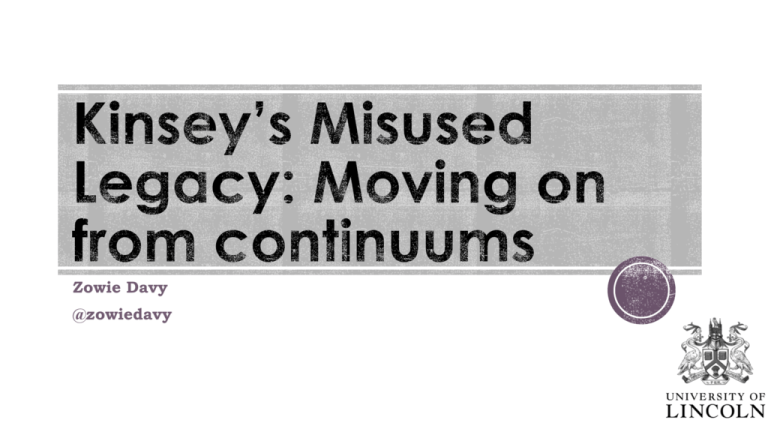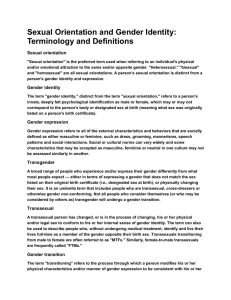
Zowie Davy
@zowiedavy
The world is not to be divided into sheep and goats. Not all things are black
nor all things white. Only the human mind invents categories and tries to
force facts into separate pigeonholes (Kinsey, Pomeroy, & Martin, 2003
[1948]: 897).
“matter of individual differences within a continuous scheme of sexual
distribution” (Bauer, 2007: 5)
Edward Carpenter’s (1912) ‘Uranians’ or ‘third sexes’
Havelock Ellis’ (1942 [1905], 1994 [1897]) ‘sexual inverts’
Hirschfeld’s (1991 [1910]) ‘sexual Intermediaries.’
trans* as "across", "beyond" or "on the opposite side”
Trans advocates’ claims are often in the form of a cerebral DSD condition (see
Brain, 2012; Gender Identity Research and Education Society, 2006;
Transgender London, 2011; TS-SI, 2008).
“Many transgender people have believed for the longest time that biology had
been the cause. I myself believe this as my earliest memories were that of
wanting to be a girl even before I learnt to spell. Hopefully further studies like
this will prove beyond a shadow of doubt that the phenomenon is a natural
occurrence, leading to social acceptance of transgender people” (SameSame,
2008).
https://www.youtube.com/watch?v=kMz5sUQmfyQ
Bancroft, J. (2004). Alfred C. Kinsey and the politics of sex research. Annual Review of Sex research, 15(1), 1-39.
Bauer, J. E. (2007). The Female Phallus: On Alfred Kinsey’s sexual vitalism, the theo-political reinstatement of the male/female divide, and the postmodern de-finitization of sexualities. Anthropological
Notebooks, 13(1), 5-32.
Brain, A. E. (2012). Another part of the puzzle. Retrieved 7th January, 2013, from http://aebrain.blogspot.co.uk/
Carpenter, E. (1912). The Intermediate Sex. London: George Allen & Co.
Cohen-Kettenis, P. (2010). Psychosocial and psychosexual aspects of disorders of sex development. Best Practice & Research Clinical Endocrinology & Metabolism, 24(2), 325-334.
Cohen-Kettenis, P., & Pfäfflin, F. (2010). The DSM Diagnostic Criteria for Gender Identity Disorder in Adolescents and Adults. Archives Of Sexual Behavior, 39(2), 499-513.
de Vries, A. L., Doreleijers, T. A., & Cohen-Kettenis, P. T. (2007). Disorders of sex development and gender identity outcome in adolescence and adulthood: understanding gender identity development and its
clinical implications. Pediatric endocrinology reviews : PER, 4(4), 343-351.
Diamond, M. (2002). Sex and gender are different: Sexual identity and gender identity are different. Clinical Child Psychology and Psychiatry, 7(3), 320-334.
Ellis, H. (1942 [1905]). Studies in the Psychology of Sex: Part Four, Sexual Inversion (Vol. Volume 1). New York: Random House.
Ellis, H. (1994 [1897]). Sexual inversion. Manchester: Ayer.
Gender Identity Research and Education Society. (2006). Atypical Gender Development–A Review. International Journal of Transgenderism, 9(1), 29-44.
Hester, D. J. (2004). Intersex(es) and informed consent: How physicians' rhetoric constrains choice. Theoretical Medicine, 25, 21-49.
Hirschfeld, M. (1991 [1910]). The Transvestite: An Investigation of the Erotic Desire to Cross-Dress (M. Lombardi, Trans.). New York: Prometheus Books.
Holmes, G. (1995). Queer Cut Bodies: Intersexuality & Homophobia in Medical Practice. Retrieved 12th September, 2002, from http://www.usc/isd/archives/queerfrontiers/queer/papers/holmes.long.html
Kinsey, A. C., Pomeroy, W. R., & Martin, C. E. (2003 [1948]). Sexual Behavior in the Human Male. American Journal of Public Health, 93(6), 894-898.
Linstead, S., & Pullen, A. (2006). Gender as Multiplicity: Desire, displacement, difference and dispersion. Human Relations, 59, 1287-1310.
Meyerowitz, J. (2002). How Sex Changed: A history of transsexuality in the United States. Cambridge: Harvard University Press.
Phillips, H. (2001, 12th May). The Gender Police. The New Scientist, 33-41.
SameSame. (2008). Transgender people Validated by Aussie Research. Retrieved 7th January, 2013, from http://www.samesame.com.au/news/local/3161/Transgender-People-Validated-By-AussieResearch.htm
The Intersex Society of North America. (1993-2008). Home Page. Retrieved 18th Feb, 2011, from http://www.isna.org/
Transgender London. (2011). Not a Choice? What Causes it? Retrieved 7th January, 2013, from http://www.transgenderlondon.com/What%20Causes%20It.htm
TS-SI. (2008). Genomic Association Study Identifies Genetic Basis for MtF Feminization. Retrieved 7th January, 2013, from http://www.ts-si.org/genetics-&-genome/3545-genomic-genetic-basis-mtffeminization.html






